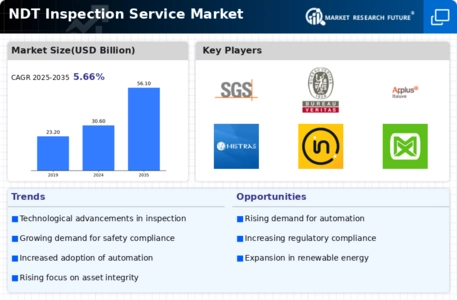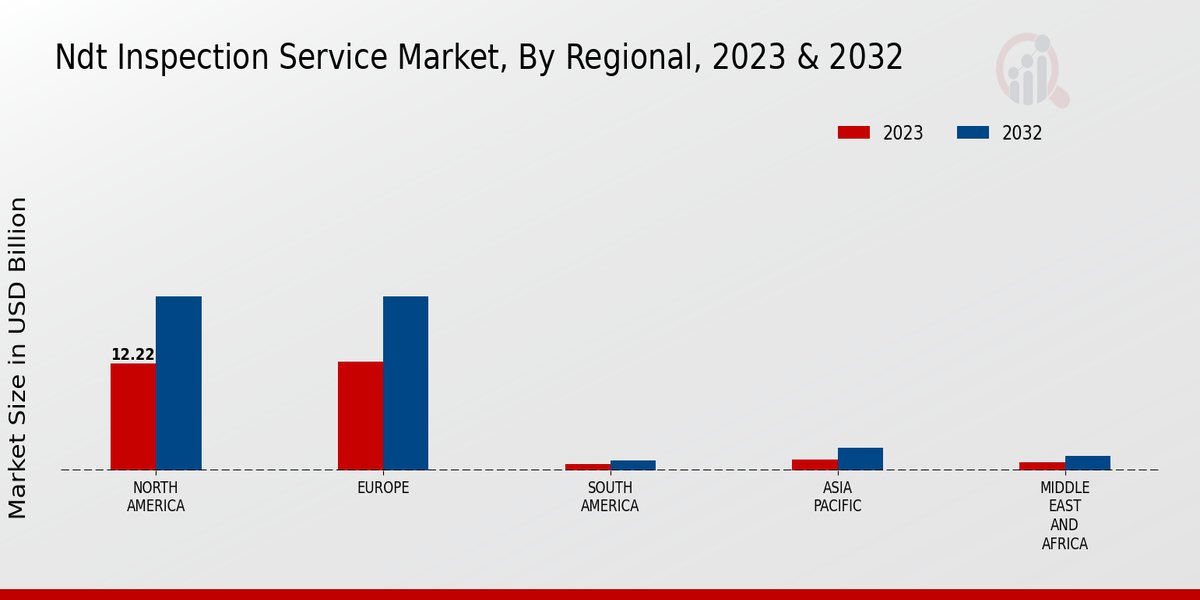Market Growth Projections
The Global NDT Inspection Service Market Industry is poised for substantial growth, with projections indicating a market size of 30.6 USD Billion in 2024 and an anticipated increase to 56.1 USD Billion by 2035. This growth reflects a compound annual growth rate of 5.66% from 2025 to 2035, driven by various factors such as technological advancements, regulatory compliance, and increasing infrastructure investments. The market's expansion is indicative of the critical role that NDT services play in ensuring safety and quality across multiple sectors, positioning it as a vital component of industrial operations.
Growth in Infrastructure Development
The Global NDT Inspection Service Market Industry is significantly influenced by the ongoing growth in infrastructure development worldwide. Governments and private sectors are investing heavily in constructing and maintaining infrastructure, such as bridges, roads, and buildings. This investment necessitates regular inspections to ensure structural integrity and safety. For example, the construction of new highways and railways requires comprehensive NDT services to detect potential flaws in materials. As infrastructure projects expand, the demand for NDT services is expected to increase, contributing to a projected compound annual growth rate of 5.66% from 2025 to 2035, underscoring the market's robust potential.
Rising Adoption in Oil and Gas Sector
The oil and gas sector is a critical driver of the Global NDT Inspection Service Market Industry, as companies seek to enhance operational efficiency and safety. Non-destructive testing is essential for inspecting pipelines, storage tanks, and drilling equipment, ensuring they meet safety standards and regulatory requirements. With fluctuating oil prices, companies are increasingly focusing on maintaining existing assets rather than new explorations, which amplifies the need for regular inspections. This trend indicates a sustained demand for NDT services, as the sector prioritizes risk management and compliance, further solidifying the market's growth trajectory.
Increasing Demand for Safety Regulations
The Global NDT Inspection Service Market Industry experiences heightened demand due to stringent safety regulations across various sectors, including aerospace, automotive, and construction. Governments worldwide are implementing rigorous standards to ensure public safety and environmental protection. For instance, the aerospace sector mandates non-destructive testing to maintain airworthiness, which drives the need for NDT services. As industries prioritize compliance, the market is projected to reach 30.6 USD Billion in 2024, reflecting a growing emphasis on safety and quality assurance. This trend suggests that adherence to regulations will continue to propel the demand for NDT services globally.
Technological Advancements in NDT Methods
Technological innovations are transforming the Global NDT Inspection Service Market Industry, enhancing the efficiency and accuracy of inspection methods. Advanced techniques such as digital radiography, ultrasonic testing, and thermography are gaining traction, allowing for real-time data analysis and improved defect detection. These advancements not only reduce inspection time but also minimize operational costs for industries. The integration of artificial intelligence and machine learning into NDT processes further optimizes performance. As a result, the market is likely to witness substantial growth, with projections indicating a rise to 56.1 USD Billion by 2035, driven by the adoption of cutting-edge technologies.
Environmental Concerns and Sustainability Initiatives
Growing environmental concerns and sustainability initiatives are shaping the Global NDT Inspection Service Market Industry. Industries are increasingly adopting non-destructive testing methods to minimize waste and reduce their environmental footprint. NDT techniques allow for the inspection of materials without causing damage, aligning with sustainability goals. For instance, the renewable energy sector, particularly wind and solar, relies on NDT to ensure the integrity of components while adhering to environmental regulations. This shift towards sustainable practices is likely to drive demand for NDT services, as companies seek to balance operational efficiency with environmental responsibility.








